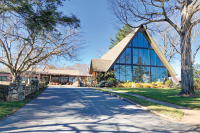New generation of doctors prefer stability over autonomy
In an effort to boost recruitment of doctors to the region, hospitals across Western North Carolina are following in the footsteps of a national trend to employ physicians in-house.
Historically, doctors set up independent, private practices.
But doctors are increasingly being squeezed by rising overhead and lower reimbursements for Medicare and Medicaid patients. As a result, doctors are gravitating toward a new model of being employed directly by hospitals. The hospitals keep the revenue generated from the patients, while providing a steady salary to the doctors.
“It allows them to do what they were trained for, the clinical work, and let someone else handle the administrative side,” said Tim Hubbs, CEO of Angel Medical Center in Franklin.
Whether it’s disciplining chronically late employees, shopping malpractice rates or billing insurance companies, “It is nice to say ‘Hey, can you all just handle that?’” Hubbs said.
Sylva-based WestCare is leading the hospitals west of Asheville in the number of physicians employed in-house. WestCare employs 19 physicians across six practices. Angel Medical Center employs 13, while Haywood Regional Medical Center employs five.
Related Items
WestCare CEO Mark Leonard said the trend reflects a generational preference among younger doctors. He cited a recent survey of medical school grads at Duke University where 74 percent said they would rather be employed upon graduating than go into their own private practice.
“This really reflects a generational shift on the part of new physicians entering into medicine,” Leonard said. “It was incumbent on us to shift and embrace this new way of doing business.”
Leonard said he understands why the new model is attractive to today’s younger doctors, citing the long shifts doctors pull simply to care for their patients.
“When you put on top of that being a business owner and doing the taxes and the personnel issues, that causes the hours to stack up,” Leonard said. “These new physicians coming out say, ‘I just went to medical school and I want to emphasize the clinical side of medicine.”
Haywood CEO Mike Poore added that young doctors aren’t eager to follow the rigorous on-call schedule that had their older peers chained to beepers most of their lives. They want a steady salary and more free time.
Balancing autonomy
The only downfall of the model is a potential loss of autonomy. Doctors can suddenly find themselves answering to a hospital CEO, unlike a private practice model where they answer to no one but their patients.
All three hospital CEOs interviewed for this story said they recognize the concern.
“When I go to my personal physician, I don’t want to be thinking that there is a suit in another room influencing how he is going to care for me, my wife or my children,” Leonard said. “I want his decision to be based on what’s in my best interest as a patient.”
At WestCare, Leonard said he has laid the foundation of trust between physicians and administration and a collaborative decision-making model, which should in turn allay such fears.
“I am not a physician. I did not go to medical school. I am going to rely on and trust the physician’s judgment when it comes to clinical decision-making,” Leonard said.
Hubbs also pledged a hands-off management style when it comes to medical care.
“If a physician says I think we need a CAT scan on this, we are not going to second guess that,” Leonard said.
For Dr. Bruce Lobitz, an ER doctor who joined a team of hospital-employed doctors in the Angel emergency room this year, the possibility of hospital administration intruding on his care of patients was a top concern.
“That was one of my hesitations,” Lobitz said, who has found it not to be the case, however. “Here, there is very little of that.”
While it might give some physicians pause, the positves seem to outweigh the negatives.
“There is some trepidation in the loss of autonomy,” said Dr. Charles Trenthem. “But if you look at the trends nationally, this is what’s happening.”
While the nonprofit hospitals in the mountains have a community minded philosophy, larger for-profit hospitals could take advantage of the employment model.
“They do have a profit model, and they do push the providers at all levels to see that one extra patient, to generate that one extra charge,” said Dr. David Farley, an internist at Angel Medical. “I have not seen that be an issue here.”
Hubbs said there are external controls to ensure hospitals don’t prod physicians to order more costly tests than a patient really needs just to boost revenue. The insurance companies or Medicare who get stuck with the bill would notice an outlier ordering gobs of tests, Hubbs said.
There is one upside for patients: fewer bills. Anyone faced with a hospital stay braces for a litany of separate bills trickling in for lab tests, X-rays, various specialists and the hospital itself. Poore said bundled payments — where the bill for doctors is included with the bill from the hospital — is a model that shows promise.
Hospitals employing a critical mass of in-house doctors will often house them in a joint practice, even if they aren’t in the same specialty. It allows for integrated patient care, providing quick access to charts and reducing the chances of two doctors ordering the same test.
“Really it is kind of a data flow issue that is so clumsy in medicine right now,” Farley said. “If you’re housed in the same unit, you can walk down the hall and say ‘What did you think of Mrs. So-and-so this morning? Should I be concerned about this?’ You don’t have that when you are all scattered around in separate pods around town.”
Making the transition
While urban hospitals have launched a large-scale transition toward employing doctors, rural hospitals are using the model primarily to lure new recruits or to stabilize a faltering practice in a specialty the hospital can’t afford to lose within its medical community, said Dr. David Farley, an internist at Angel Medical.
“In this town, most of the employed physicians are the new recruits,” Farley said. “The existing doctors have remained solo, but I don’t think you can predict that will continue.”
Farley said the new model could be enticing to physicians at different points in their career, like a physician nearing retirement who wants to go part-time and no longer wants to deal with the hassle of managing a private practice.
As the new model develops, the result is a hybrid of traditional private practices and hospital-employed physicians within the community, Leonard said. Leonard largely follows the preferences of the doctor being recruited. If there is an existing private practice in the community the doctor wants to join, the hospital simply plays matchmaker.
When a doctor joins an existing practice, they are often expected to make an upfront investment.
“They buy in to do their fair share,” Poore said.
In Haywood County, both models exist within the same orthopedics office. Western Carolina Orthopedic Specialists has three doctors, two of whom own the private practice, while a third, Dr. Gerald King, is an employee of the hospital.
The hospital pays Western Carolina Orthopedic Specialists a management fee to covers King’s share of overhead, from office space to secretarial staff. The hospital also pays Kings salary.
In exchange, the hospital gets 100 percent of the revenue generated from King’s patients. It also benefits from having an orthopedist in the county who will bring business through the doors of the hospital. The hospital was suffering from a chronic orthopedist shortage that led patients unable to get appointments locally to take their business outside the county.
Haywood Regional Medical Center recently bought out Haywood Women’s Medical Center, the only Ob-Gyn practice in the county. The hospital now owns the practice and the doctors are employees of the hospital.
It was one of the first moves toward hospital-employed physicians in Haywood. The Ob-Gyn practice was a good starting place for several reasons, Poore said.
For one, doctors who deliver babies have some of the highest overhead.
“The malpractice is unbelievably high,” Poore said.
But the service is so crucial, no well-rounded hospital could afford to be without it.
“Our goals was to keep a viable Ob-Gyn practice in Haywood County,” Poore said.
Buying out an existing practice is more complicated than setting up the arrangement from the get-go with new hires. The process took six months and required outside consultants to help arrive at a fair purchase price.
Getting squeezed
The new model is particularly attractive to doctors in a climate of decreasing reimbursement rates for Medicare and Medicaid patients. Doctors take a bigger hit in rural areas, where a higher percentage of patients are likely to be on Medicare or Medicaid. It makes the offer of employment — and the steady salary that goes with it despite the poverty level of patients — an even more important recruiting tool in rural areas, according to Dr. Charles Trenthem, an anesthesiologist and chief of staff at Angel Medical Center.
“If we weren’t employing physicians and subsidizing their practices, the health care in Western North Carolina would suffer,” Trenthem said.
Angel Medical recently got a special “critical access” designation for its hospital that gets it a higher reimbursement rate from Medicare and Medicaid. Physicians employed by the hospital also enjoy the higher reimbursement rate, since billing is done by the hospital itself.
The issue is particularly acute in emergency room settings, where doctors are likely to see a higher number of patients without insurance who have no means to pay their bills.
While ER doctors theoretically treat patients without regard for whether they can pay, it can influence doctors on a subconscious level, said Dr. Bruce Lobitz, an ER doctor at Angel. But as a hospital-employed physician with a steady salary regardless, it makes it easier for doctors to ignore a patient’s ability to pay when providing care.
“I don’t care about the patient’s payer status. The hospital takes care of all that,” Lobitz said.
The hospital is left to absorb the hit, which can be a problem for rural hospitals already operating on a paper-thin margin, Trenthem said. The model also saddles hospitals with the upfront investment of setting up a new doctor and shouldering the risk if patient revenue falls short.
“Costs are being shifted to these smaller hospitals,” Trenthem said.
But given the trend, they had no choice but step up to the plate and adopt the model.
“The days of a physician going out and hanging a shingle are kind of over now,” Trenthem said.









